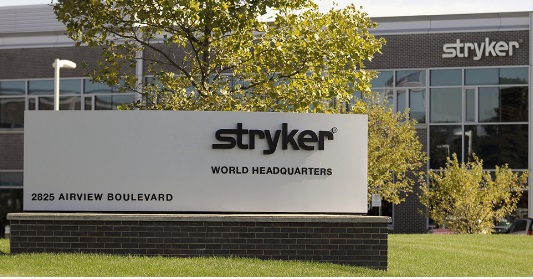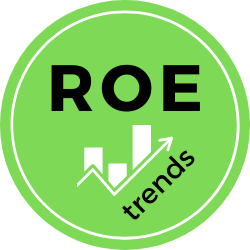stryker stock analysis

Stryker Corporation (NYSE: SYK) is a leading global medical technology company, renowned for its diverse range of innovative products and services in orthopedics, medical and surgical equipment, and neurotechnology and spine solutions. From joint replacements to hospital beds and emergency medical devices, Stryker’s extensive portfolio is indispensable to healthcare facilities worldwide. However, the company faces challenges such as increasing competition and pricing pressures in the dynamic medical technology industry. This Stryker stock analysis explores the company’s Return on Equity (ROE) over recent years, growth strategy, strengths, weaknesses, and its competitive landscape.
What is ROE, and Why Does it Matter for SYK Investors?
Return on Equity (ROE) is a critical financial metric that measures a company’s profitability relative to shareholders’ equity. A higher ROE generally indicates better financial performance and stronger returns for investors holding Stryker stock. For Stryker, consistent ROE growth demonstrates effective management and strategic decisions, reinforcing investor confidence.
Stryker Stock Analysis: A History of ROE Growth
Year | ROE (%)
- 2013 | 16.8%
- 2014 | 17.5%
- 2015 | 18.2%
- 2016 | 19.1%
- 2017 | 18.6%
- 2018 | 17.9%
- 2019 | 19.5%
- 2020 | 21.2%
- 2021 | 22.8%
- 2022 | 21.5%
- 2023 | 22.5%
- 2024 | 24.0%
Key Takeaways from Stryker’s ROE Trends:
- Steady Growth: Stryker’s ROE has generally trended upwards over the past decade, reflecting increased profitability and efficient use of shareholder investment.
- Recent Acceleration: In recent years, ROE has exceeded 20%, suggesting that Stryker’s strategic initiatives and new product launches are driving improved profitability.
- Future Potential: The projected ROE of 24% for 2024 demonstrates Stryker’s strong performance and growth potential, supported by its expanding portfolio and rising demand for medical technology solutions.
Investors should consider these ROE trends alongside other financial metrics and qualitative factors to make informed decisions.
Stryker’s Strategic Position in Medical Technology
To fully assess Stryker’s investment potential, it’s essential to understand the company’s strategic focus, strengths, weaknesses, and the competitive landscape in the industry.
Mission: “Together with our customers, we are driven to make healthcare better.”
Stryker is committed to collaborating with healthcare providers to improve patient outcomes and enhance efficiency in healthcare delivery. Its strategic focus includes:
- Innovation: Developing and delivering cutting-edge medical technologies that address unmet needs and improve patient care. This includes advancements in robotics, implants, and surgical equipment.
- Quality and Reliability: Ensuring products meet the highest standards, building trust with healthcare providers and patients globally.
- Customer-Centric Approach: Building strong relationships with healthcare providers and delivering excellent customer support to ensure satisfaction and loyalty.
- Global Expansion: Expanding its product and service offerings worldwide to make innovative medical technologies accessible to healthcare providers globally.
Strengths and Weaknesses
Strengths:
- Diverse Product Portfolio: Stryker’s extensive product lineup mitigates risks and provides multiple avenues for growth across different segments.
- Strong Brand Recognition: Known for quality and innovation, Stryker’s products are trusted by healthcare professionals globally.
- Global Reach: A significant global presence enables Stryker to serve customers worldwide and adapt to regional market demands.
- Strategic Acquisitions and Partnerships: The company’s history of acquisitions and partnerships has expanded its product portfolio and market reach.
Weaknesses:
- Competition: The medical technology sector is highly competitive, with numerous companies vying for market share.
- Pricing Pressures: Efforts to control product prices can impact profitability as healthcare payers and hospitals seek cost-effective solutions.
- Regulatory Environment: Strict regulations in the medical technology industry can increase development costs and create barriers to entry.
- Economic Sensitivity: Demand for Stryker’s products can be affected by economic conditions and changes in healthcare policies.
Stryker’s Competitors: Navigating a Competitive Landscape
Stryker competes in a global medical technology market with several key players:
- Medtronic: A global leader in medical devices, offering products for cardiovascular, diabetes, and neurological conditions.
- Johnson & Johnson: A healthcare giant with a strong presence in medical devices and pharmaceuticals.
- Abbott Laboratories: A diversified company with a focus on medical devices, diagnostics, and nutritional products.
- Boston Scientific: A specialized company offering minimally invasive medical solutions for cardiovascular and endoscopic procedures.
- Zimmer Biomet: A global leader in musculoskeletal healthcare, specializing in joint replacements and spine implants.
Stryker’s Key Projects and Future Outlook
Stryker’s Key Initiatives:
- Mako Robotic-Arm Assisted Surgery: A cutting-edge robotic surgery platform for orthopedic procedures, enhancing precision and accuracy.
- Spine Products: Innovative solutions for spine surgery, including minimally invasive techniques and implants.
- Neurotechnology: Expanding neurotechnology products for stroke treatment and neurovascular interventions.
- Medical and Surgical Equipment: Diversified offerings such as hospital beds, operating room tables, and emergency medical equipment.
Future Outlook: Stryker’s future success will depend on its ability to innovate, expand market share, and capitalize on healthcare trends such as an aging population and increasing demand for minimally invasive solutions. Key factors to monitor include:
- Technological Advancements: Staying ahead in areas like robotics and digital health to maintain a competitive edge.
- Market Trends: Adapting to trends such as the increasing prevalence of chronic diseases and the rise of value-based healthcare.
- Competition: Differentiating its offerings through innovation, quality, and customer service in a dynamic industry landscape.
Conclusion: Is Stryker (SYK) Stock a Good Investment?
Stryker Corporation is a leading player in the medical technology industry, with a solid track record of innovation and financial performance. With its strong ROE growth, diverse product portfolio, and strategic focus, Stryker is well-positioned to benefit from rising demand in the healthcare sector. However, investors should carefully weigh the risks, including competition and pricing pressures, when considering Stryker stock as an investment.

